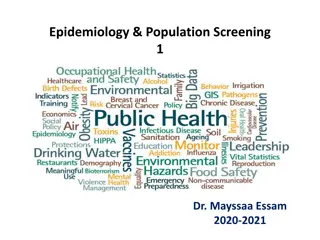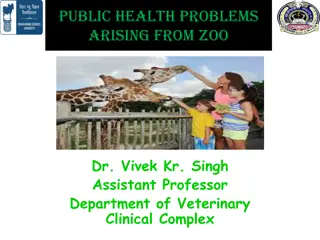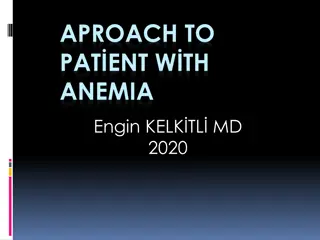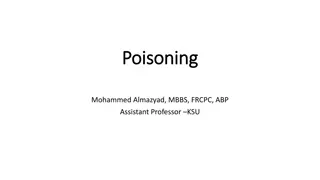Understanding Leptospirosis: Causes, Symptoms, and Epidemiology
Leptospirosis is a bacterial disease affecting humans and animals caused by the Leptospira genus. Symptoms range from kidney damage to death if untreated. The disease has various synonyms and is caused by pathogenic leptospires. It is prevalent in both animals and humans globally, with various serovars associated with common animals. The spread is often underreported due to its varied forms and challenging diagnosis.
Download Presentation

Please find below an Image/Link to download the presentation.
The content on the website is provided AS IS for your information and personal use only. It may not be sold, licensed, or shared on other websites without obtaining consent from the author. Download presentation by click this link. If you encounter any issues during the download, it is possible that the publisher has removed the file from their server.
E N D
Presentation Transcript
Leptospirosis is a bacterial disease that affects humans and animals. It is caused by bacteria of the genus Leptospira. In humans, it can cause a wide range of symptoms. Without treatment, Leptospirosis can lead to kidney damage, meningitis, liver failure, respiratory distress, and even death
Synonyms Autmnal fever, Cane cutter's disease, Canicola fever, Harvest fever, Infectious jaundice, "Lepro", Mud fever, Rice field worker's disease, Seven day fever, Swamp fever, Swine herd's disease, Walter fever, Weil's disease Fort Braggs disease Fish handlers disease
Etiology Caused by- L. interrogans Genus- Leptospira (Group1- Spirochaets) L. interrogans (Parasitic & Pathogenic ) (Saprophytic & Non-pathogenic ) L. biflexa Pathogenic leptospires have been divided into 38 groups and 65 serovars Leptospires are flexible, motile (with cork-screw like rotating axial filament), helicoidal (spiral) rods (0.1 x 6-20 ) with one or both hooked end(s). Best viewed by: Dark field microscope, FAT and silver impregnation Not seen by an ordinary microscope
Epidemiology InAnimals Worldwide Occurs in the form of inapparent infections or varied clinical manifestations The disease has been identified in all domestic animals, pets, almost all of the species commonly kept in zoological gardens or as laboratory animals, and majority of wild animals particularly rodents Reported more frequently: Southern states although few reports are also available from western states (Gujarat and Rajasthan)
Serovars associated with common animals Animals Rats field mice Ccattle,Sheep Pig Dogs Serovars L. icterrohaemorrhagiae L. grippotyphosa L. hardjo L. pomona & L. tarassovi L. icterohaemorrhagiae and canicola L. pomona Horses
Epidemiology In man The disease is distributed globally Disease is underreported due to lack of awareness, its varied forms and difficult diagnosis The disease is widespread in many states including Andaman, Andhra Pradesh, Bihar, Haryana, Karnataka, Kerala, Madhya Pradesh, Maharashtra, North-east Punjab, Tamil Nadu and West Bengal
Host range and reservoirs Domestic -Cattle, buffalo, sheep, goat, pig, horse etc. Wild species- Elephant, deer, monkey etc. Rodents- Many species of rats, domestic and field mice, gerbils, voles, beavers, coypa, bats, rabbits, hares and squirrels Carnivores-Dogs, cats, jackals, foxes, mangooses, skunks, civets and racoons), parcupians Insectivores (hedgehogs, shrews) and frogs may also act as carriers/ hosts Cats are susceptible to experimental infection Birds including domestic poultry are resistant, however, wading birds may act as passive carrier of infection
High risk group Agricultural workers (Particularly those engaged in rice, pineapple and sugarcane farms) Swimmers Persons venturing into natural wild habital of rodents
Transmission Animals Transmission is carried out along with urinedroplet, insects or contaminated water by means of contact or ingestion Congenital or neonatal infection (transplacental) Venereal route involving coitus, insemination with infected frozen semen and contact with contaminated genitalia, Inhalation of urine or contaminated water droplets (aerosol), Nursing of young ones since the pathogen may be present inside or on the surface of udder Ectoparasiteslike ticks, mosquitoes, bed bugs and flies by mechanical means (possible but not proven) to reproductive, intestinal and urinary tracts Humans Contact with urine (or other body fluids except saliva), tissues, and placenta of infected subjects from infected animals Contact with water, soil, or food farm yard floors, sewage, muddy grounds, mines, agricultural fields contaminated with the urine of infected animals The bacteria can enter the body through skin or mucous membranes (eyes, nose, or mouth), especially if the skin is broken from a cut or scratch Person to person transmission is rare
Main mode of transmission are .. Ingestion of contaminated material Inhalation of urine droplet Contact with infected material Congenital, neonatal, venereal route The organism enter the host via .. Mucous membrane of the eyes Genitals Nasopharynx or The alimentary tract Leptospires can survive for weeks in soil and water frequently contaminated by urine of carriers, particularly if the pH is alkaline
Symptoms 1. Cattle The infection is usually in-apparent In acute form: Sudden anaemia/jaundice, haemoglobinurea, abortion (usually late in pregnancy, 3- 12 weeks post infection) and depression may be seen (40-41.1 C), onset of elevated temperature anorexia, In subacute form: Onset is slow, "milk drop syndrome" due to mastitis resulting in reduced yield, thick flaking (like of colostrum) and yellow to blood coloration of milk is common. The symptoms lasts for about 2 weeks. Jaundice may be seen in some cases In chronic form: Abortions, still births, foetal deaths, weak calves and retained placenta cases are common in herds
Symptoms 2. Swine: Usually shows mild or inapparent Only one or few affected pigs show acute signs of anorexia, pyrexia and/ or diarrhoea for 1-3 days Chronic cases Abort in late pregnancy/ give birth to weak piglets that fail to survive Recover usually but become renal shedders for at least 6 months Occasionally may show high temperature 3. Dogs: The acute form of disease, known as "stuttgart disease" Characterized by vomiting, rapid dehydration, collapse, necrosis and sloughing of buccal mucosa and tongue, the occasional passage of blood stained faeces, and high mortality Elevated body temperature, depression, deep sunken eyes, anorexia, muscle tenderness, vomiting, intussuseption, foul breath, ulcerated gums are usually associated with anaemia and extensive jaundice that may lead to death
Symptoms 4. Horses : Rare and usually mild, include pyrexia, icterus, periodic opthalmia and abortion 5. Sheep : Abortion, fever, agalactia, dysponea, jaundice, haematuria and sudden death 6. Goats : May remain symptomless but shed leptospires in the urine for short periods or May develop jaundice, haemaglobinurea and abortions
Symptoms Incubation period -7-14 days Early or Leptospiaremic phase The pathogen appears in blood and cerebrospinal fluid (CSF) 'flu-like' syndrome which is characterized by sudden high fever, chills, headache, muscle aches, vomiting and conjunctivitis Most of the cases (90%) recover completely from the milder form of infection even without medication Second or Immune phase/Weil's syndrome Mild fever is noticed as the blood infection disappears due to action of phagocytes, IgM and complement Gradually worsen leading to kidney and liver failure, of which the latter results in jaundice Widespread haemorrhages occur leading to anaemia, coma and finally death (mainly in elderly or due to virulent strain). "Red eye" (conjunctival suffusion due to immune reaction ) is a constant and characteristic feature All the severe form have a mortality rate of 5-10%
Diagnosis The disease can be tentatively diagnosed on the basis of: Clinical symptoms History Cases in high risk group Case from endemic area Confirmatory diagnosed by: a. Direct examination of the samples (Samples: Blood, CSF, urine, tissue scrapping/emulsion, kidney, brain, aborted foetus, semen) 10% acetic acid/5-19 min (in case of impression smears) 40% formalin (to decontaminate i.e. urine) 0.25% trypsin/3-5 min (in case of tissues) (i)Dark field microscopy: Leptospires are best seen under dark field at 400x magnification (ii)Silver staining (Fontana stain): Visualization of leptospires in silver stained tissue sections is possible but it lacks specificity
Diagnosis b. Isolation of Leptospires The conventional methods to detect leptospires in clinical or morbid materials especially blood are confirmatory (i) Culture Media containing serum (Korthof's medium, Stuart's medium, Fletcher's semi- solid medium etc.) Media containing bovine albumin fraction V and tween 80 (EM medium, EMJH medium, protein free medium, Ellis medium etc.) Synthetic media (not used routinely) (i) o In Gerbils: 106 leptospires inoculum induces a fatal reaction in 3-5 days o In Hamsters (3 weeks old): 0.5-1 ml i/p (foetal infection with jaundice) o In Guinea pigs (1 week old): 0.5-1 ml material, i/p Seldom die of the infection Killed after 21 days for the recovery (iii) Culture following animal inoculation Animal inoculation
Diagnosis (c) (i) Microscopic agglutination test (MAT): Common diagnostic tests Different dilution of pre filtered serum, heating at 56oC/20 min to in-activate the complement + 4-14 days old culture live/lypholized culture (1-2x 108organism/ml) WHO reference test It is a fast Specific Most widely used test -4 h or overnight The dilution which is showing >50% cells show agglutination or lysis on examination on dark field A titer of 100 or more indicates the present or past infection
Diagnosis (ii)Macroscopic agglutination tests : The two tests namely (a) Galton macroscopic slide agglutination test, (b) Mazzonelli-Mailloux (M-Mx) slide test have been described for viewing agglutination through naked eye (iii) ELISA: High sensitive and specific it is used to detect IgG and IgM antibodies separately in infected subject (iv) Indirect haemagglutination (IHA) test : The Leptospira antigens are first used to sensitize sheep or human RBCs which then agglutinate with antibodies present in the serum of the animal or man (v) Complement fixation test (CFT) (vi) Sensitized erythrocytes lysis test
Diagnosis Diagnostic tests for rapid or early detection These are sensitive and specific however, not routinely used in practice (i)Immunofluorescence test (ii)Polymerase chain reaction (PCR) (iii)Micro capsule agglutination test (MCAT) (iv) Radio-immunoassay (RIA) (v) Passive haemagglutination (PHA) test (vi)Rapid microscopic agglutination test (RMAT)
Treatment Dihydrostreptomycine Doxycycline Ampicillin or amoxicillin Azithromycin or clarithromycin Fluoroquinolone such as ciprofloxacin or levofloxacin Antibiotics for leptospirosis requiring hospitalization include the following: I/V penicillin G I/V third-generation cephalosporins (cefotaxime and ceftriaxone) I/V ampicillin or amoxicillin (second-line agents) I/V erythromycin (in penicillin-allergic pregnant women)
Immunization: Strain-specific killed vaccines for human use, particularly in endemic areas, are available but these have limited use due to many infecting serotypes. Vaccination is valuable when large numbers of workers are exposed to infection in situations (e.g. rice fields) that preclude satisfactory control of reservoir hosts
Control In animals 1. Rodent control : In the areas which favour rodent survival and growth such as crop fields (rice and sugarcane), animal feed and grain processing units, recreational sites, domestic environments and animal house; the rodent control should be exercised by suitable means including (i) By the use of rodenticide (2% zinc phosphide is very effective) or anticoagulants, (ii) Use of predators (cat, eagle etc.), (iii) Trapping, (iv) Biological control either by manipulating or altering the habitat, (v) Mechanical proofing, (vii) Rodent repellents, (vii) Electronic barriers (fencing), (viii) Fumigation, (ix) Proper storage of foods, animal feeds and grains, and (x) General cleanliness of surroundings which includes proper fencing in order to protect them from pollution with rat feces, and burning of dry leaves and bushes particularly in sugarcane and rice fields before harvest
Control 2. Sanitation (i) Proper draining of yards, pens, sheds and kennels and their regular disinfection (with cresol or 1:4000 solution of sodium hypochlorite etc.), (ii) avoidance of stagnation of water, urine and faeces, and (iii) burial or burning of infected carcasses, aborted foetuses, placentas and/or bedding 3. Proper management (i) Breaking of the cycle of infection, (ii) Quaratine for 30 days, (iii) Sero-testing of herd by MAT 4. Immunization (i) Monovalent and multivalent vaccines are available for the vaccination in animals
Control In Humans 1. Personal hygiene and protection: (i) Drink boiled or chlorinated water, (ii) Wash hands with disinfectants, (iii) Drink pasteurized or boiled milk (iv) Protect food articles and utensils from contamination with urine of rat, (v) Encourage use of protective clothings (rubber gloves, goggles, gum- boots particularly when working in water logged areas or handling animals/animal products during slaughterting and parturition etc., (vi) Avoid swimming and wading in water of lakes, ponds, swimming pods contaminated with urine of rats and livestock, and (vii) Encourage mechanization of agricultural operations
Control In Humans 2. Sanitation : It includes (i) Disinfection of contaminated work areas such as food stores, abattoirs, fish and meat processing plants and animal sheds, (ii) Proper collection, transport, treatment and secured disposal of garbage, (iii) Proper collection, treatment and secured disposal of animal excreta, (iv) proper disposal of dead and infected animals, (iv) Disinfection of swimming pool with chlorine, (v) Drainage of wet areas, and (vi) Rodent control in the areas of domestic and farm environment. 3.Animal related care: It calls for (i) Care in handling of laboratory and other animals as they may be carriers, (ii) Regular immunization of domestic animals to protect them from disease and from becoming carriers, and (iii) Improvement in occupational hygiene standards in cattle and pig farms 4. Health education: (i) General people and particularly the high risk groups should be educated about the disease, and the protective measures to be followed including prohibition of recreational activities in contaminated waters.























